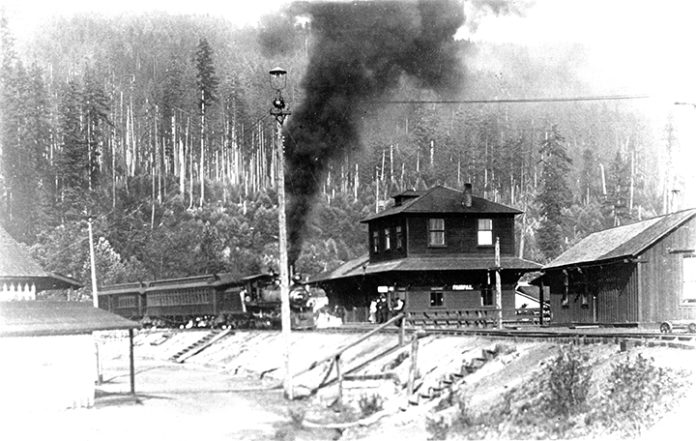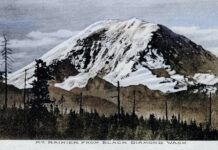The date of the photo isn’t known, but the scene would be familiar to those who traveled by train in east Pierce County, Washington during the early 1900s. The town is Fairfax, located southeast of Carbonado near the Carbon River. It was the last stop on a rail line originating in Tacoma which also served South Prairie, Wilkeson, Burnett, Spiketon, Carbonado, and Melmont. Until 1921, the railroad was the only way to reach Fairfax. Coal in the Fairfax area was discovered by W.E. Williams and his father in 1892. The town was named by Hobart W. McNeill, an Iowa railroad and coal investor who headed the Western American Company.
Like all coal mining towns of the era, A railroad connection was critical for development. Without a railroad there could be no coal mining, but without a coal mine there would be no railroad. McNeill undertook construction of the seven-mile rail line and made mining possible. McNeill died in January 1900, just as the town he brought to life began its rapid growth Three months after his death, placer gold was found in the Carbon River near Fairfax generating excitement and news stories. But those prospects didn’t pan out.
By the early 1900s, Fairfax boasted about 500 residents, a hotel, and several dozen homes. Sixty coke ovens consumed almost the entire output of the town’s mines, typically 20-30,000 tons per year. Coke is a porous fuel with a high carbon content and few impurities, made by heating coal in the absence of air to drive off volatile gasses. The coke was principally used in Tacoma blast furnaces for smelting. A sawmill operated by the Manley-Moore Lumber Company added to the town’s prosperity. Later, the Montezuma mine led to the establishment a cluster of nearby homes, with Fairfax serving that hamlet’s commercial need.
When blast furnaces closed around 1924 in favor of improved metallurgical practices, the demand for Fairfax’s coke virtually ceased. Mine operations ceased in 1930, so only logging and milling remained at Manley-Moore. That too ended several years later due to the Great Depression. Soon, Fairfax was almost a ghost town with only a newly built school building left standing. The Fairfax school survived until the 1960s, but like the rest of the town, it too eventually perished. State Route 165 passes through what was once Fairfax on its way to Mt. Rainier National Park thanks to completion of the 240-foot-high Fairfax Bridge in 1921. When built, it was the highest bridge in the state. This photo comes courtesy of JoAnne Matsumura, an Issaquah historian and collector of vintage photos.







